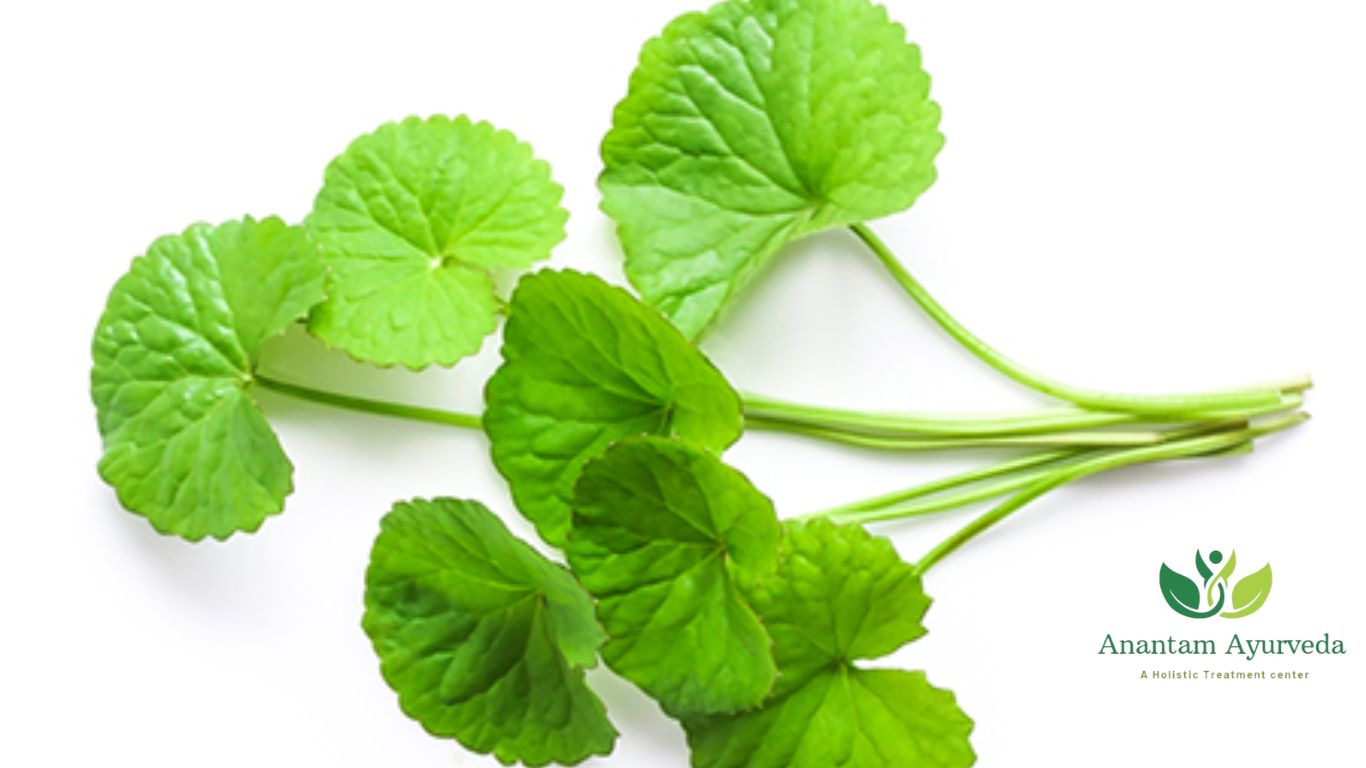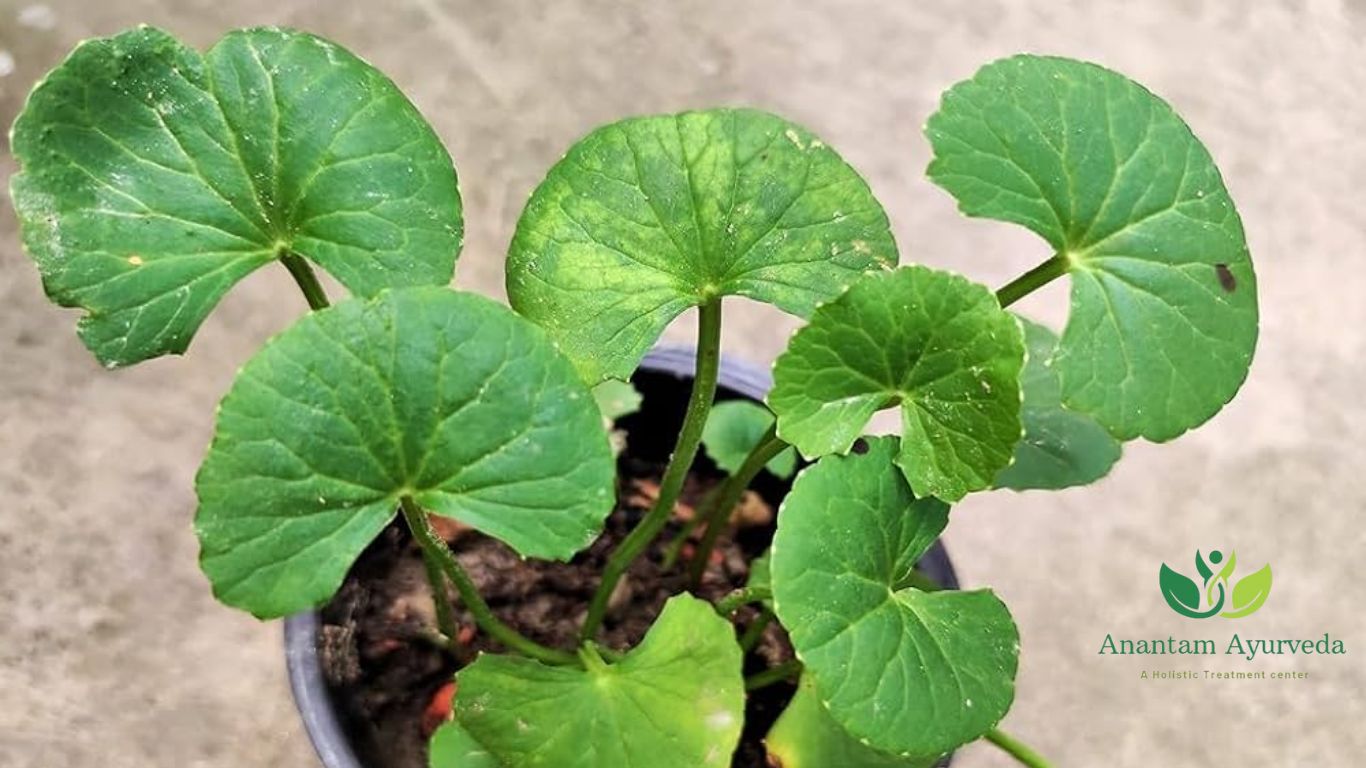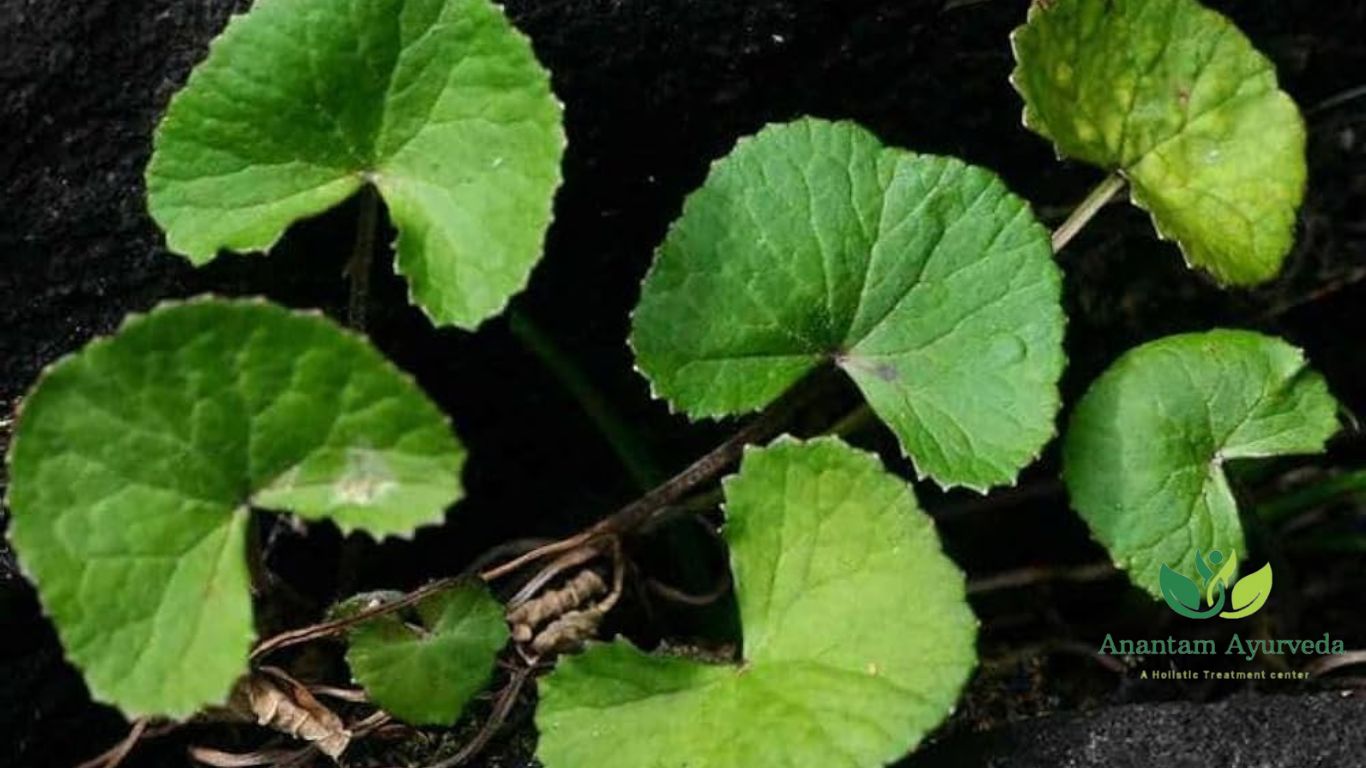Mandukaparni (Centella asiatica) : Is Mandukaparni & Brahmi Same?
Introduction of Mandukaparni
Mandukaparni, commonly known as Gotu Kola (Centella asiatica), is a revered herb in Ayurveda, known for its powerful medicinal properties. It has been widely used in traditional healing systems, including Ayurveda, Siddha, and Traditional Chinese Medicine. The name “Mandukaparni” is derived from its frog-shaped leaves, resembling the webbed feet of a frog (Manduka = frog, Parni = leaf). This herb is classified as a Medhya Rasayana (brain tonic) and is widely used to enhance cognitive functions, rejuvenate the nervous system, and promote overall well-being.
Classical Categorization of Mandukaparni
In Ayurveda, classical texts like the Charaka Samhita, Sushruta Samhita, and Bhav Prakash Nighantu categorize herbs based on their therapeutic properties, actions, and benefits. Here’s how Mandukaparni (Centella Asiatica) is categorized in these texts:

Charaka Samhita:
-
Vayasthapana:
- Mandukaparni is considered an herb with rejuvenating and anti-aging properties. It supports Vayasthapana by promoting vitality and longevity, helping to slow down the aging process and maintain youthful energy and function.
-
Tiktaskandha:
- As Mandukaparni has a slightly bitter taste, it falls under the Tiktaskandha category. Bitter herbs are known to balance the Pitta dosha, detoxify the body, and improve digestive function, which aligns with Mandukaparni’s properties.
-
Prajasthapana:
- Mandukaparni is also used in Ayurvedic practices to support reproductive health, especially in females. It is believed to have nurturing properties that protect pregnancy, aligning with Prajasthapana.
Sushruta Samhita:
- Tiktavarga:
- Similar to Tiktaskandha, Mandukaparni fits within the Tiktavarga category of herbs. Its bitter taste helps detoxify the body, clear excess heat, and calm the Pitta dosha, making it useful in managing inflammatory conditions.
Bhav Prakash Nighantu:
- Guduchyadi Varga:
- Mandukaparni is mentioned in the Guduchyadi Varga (group of herbs), which are primarily known for their immune-boosting, anti-inflammatory, and detoxifying effects. These herbs are used for their general health-promoting properties, similar to the benefits of Mandukaparni.
Mandukaparni Ayurvedic Properties
-
Rasa (Taste): Tikta (Bitter)
-
Guna (Qualities): Laghu (Light to digest)
-
Vipaka (Taste conversion after digestion): Madhura (Sweet)
-
Veerya (Potency): Sheeta (Cold)
-
Effect on Tridosha: Primarily balances Kapha and Pitta due to its bitter taste, while also pacifying excess Vata in some conditions.
-
Prabhava (Special Effect): Medhya – Enhances cognitive functions, improves intelligence, and supports mental clarity.
- Pharmacological Activities:
-
Memory Enhancer – Supports cognitive function and improves retention power.
-
Anti-inflammatory – Reduces inflammation and supports wound healing.
-
CNS Depressant – Calms the nervous system, aiding in stress and anxiety management.
-
Sedative – Promotes relaxation and improves sleep quality.
-
Hypotensive – Helps regulate blood pressure and supports cardiovascular health.
-
Hepato-protective – Aids in liver detoxification and promotes liver health.
-
Vernacular Names and Sanskrit Synonyms of Mandukaparni
- Hindi: Bengsag, Brahmi
- Bengali: Thulkudi
- Telugu: Sarasvathy Aku, Manduka Brahmi
- Tamil: Vallari Kirai
- Marathi: Karivan, Karivana
- Gujarati: Khanda Brahmi
- Kannada: Ondelaga Soppu
- Malayalam: Muttil
Sanskrit Synonyms
- Mandukaparni: Leaves resemble the shape of a frog
- Manduki: Grows in moist places, like frogs; propagated by Manduka Rishi
- Sarasvati: Found in watery areas, improves intelligence
- Mahaushadhi: One of the best medicinal plants
- Tvashti: Believed to be an abode of goddess Laxmi
- Brahmi: Often associated with Bacopa monnieri
Botanical Description of Mandukaparni
Mandukaparni (scientific name: Centella Asiatica), also known as Gotu Kola, is a popular herb in traditional Ayurvedic and Chinese medicine, known for its cognitive, skin-healing, and anti-inflammatory properties. Here’s a detailed botanical description of Mandukaparni:
Family:
- Apiaceae (Umbelliferae)
Common Names:
- Mandukaparni (Ayurvedic name)
- Gotu Kola (English name)
- Brahmi (In some regions, though Brahmi is also associated with Bacopa monnieri)
- Indian Pennywort

Habitat and Distribution of Mandukaparni
-
Habitat: Centella asiatica thrives in tropical and subtropical regions, preferring moist, marshy areas, such as wetlands, riverbanks, and pond edges.
-
Distribution: It is found across many countries, including India, Sri Lanka, China, Indonesia, South Africa, Madagascar, and Australia.
Morphological Features of Mandukaparni (Centella Asiatica)
-
Plant Type:
- Herbaceous: Mandukaparni is a low-growing perennial herb.
-
Stem:
- Creeping and Prostrate: The plant has slender, trailing stems that spread across the ground. The stems are green, and they may root at the nodes, forming a dense mat.
- Size: The stems can grow up to 30-40 cm long.
-
Leaves:
- Shape: The leaves are round to ovate, kidney-shaped (resembling a small frog’s footprint, which is why it is also called “Indian Pennywort”), and are often deeply serrated or scalloped at the edges.
- Size: The leaves are small, typically 2-4 cm in diameter, but they can vary in size.
- Color: The leaves are bright green, with a glossy texture and a prominent central vein.
-
Flowers:
- Size and Color: The flowers are small and light pink or white, growing in small clusters. They typically bloom during the warmer months.
- Structure: The flowers are delicate and borne on short, slender stalks. The plant produces tiny, umbrella-like clusters of flowers.
-
Fruits:
- The fruit is a small, rounded, one-seeded capsule that is brown when mature. Each plant produces numerous tiny fruits after flowering.
-
Roots:
- The plant has fibrous, shallow roots that spread horizontally beneath the soil, often along the nodes of the creeping stem.
Key Morphological Characteristics:
- Leaf Shape: The kidney-shaped leaves are a key feature, with a prominent central vein and serrated edges.
- Creeping Habit: It has a sprawling, low-growing, and spreading growth form.
- Small Flowers: The light-colored, small flowers in clusters are a distinctive feature.
- Herbaceous Growth: It is a non-woody, perennial herb with a mat-like growth habit.
Useful Parts of Mandukaparni
- Whole plant (Leaves, roots, and stems)
Chemical Composition of Mandukaparni
- Triterpenoids (Asiaticoside, Madecassoside, Asiatic acid, Madecassic acid)
- Flavonoids (Quercetin, Kaempferol)
- Polyphenols
- Essential oils
- Alkaloids
Pharmacological Actions and Benefits of Mandukaparni
Mandukaparni (Centella asiatica) is a versatile herb with extensive therapeutic properties recognized in both modern science and Ayurveda. It supports mental health, enhances cognitive functions, promotes skin health, and aids in managing various medical conditions.

1. Mental Health and Cognitive Support
- Anxiety Relief: Mandukaparni helps reduce anxiety through its anxiolytic properties, regulating neurotransmitters to promote mental calmness. In Ayurveda, it calms the nervous system by balancing Vata dosha and alleviates anxiety symptoms.
- Improved Mental Alertness: While scientific evidence is limited, Mandukaparni, especially when combined with Ashwagandha, may enhance cognitive functions and mental alertness. Ayurveda credits it with enhancing mental clarity and strengthening the nervous system.
- Brain Tonic & Cognitive Enhancer (Medhya Rasayana): It improves memory, intelligence, and concentration while managing conditions like anxiety, stress, ADHD, and Alzheimer’s disease by supporting nerve regeneration.
2. Cardiovascular and Circulatory Health
- Blood Clot Prevention: Mandukaparni’s antioxidant properties help prevent blood clots by reducing cholesterol and supporting nitric oxide synthesis, which prevents platelet aggregation.
- Heart and Blood Vessel Health: It reduces high blood pressure, improves circulation, prevents atherosclerosis, and strengthens blood vessels, reducing the risk of varicose veins.
3. Metabolic and Digestive Benefits
- Diabetes Management: It aids in regulating blood sugar by reducing carbohydrate breakdown, enhancing insulin secretion, and protecting pancreatic cells with its antioxidant properties.
- Digestive Support (Pachana & Deepana): Mandukaparni improves digestion, alleviates Kapha-related indigestion, and supports the management of ulcers, gastritis, irritable bowel syndrome (IBS), and liver detoxification.
4. Liver Health
- Liver Protection: Mandukaparni helps protect against liver diseases by promoting liver cell regeneration, increasing protein synthesis, and reducing oxidative damage.
5. Skin Health and Wound Healing
- Skin Regeneration (Twak Doshahara): It treats skin conditions such as eczema, psoriasis, and leprosy, promotes wound healing, reduces scars, and prevents infections through its antimicrobial and collagen-enhancing properties.
- Wound Healing: Both Mandukaparni gel and its paste mixed with coconut oil accelerate skin cell regeneration, reduce inflammation, and promote healing.
6. Energy and Vitality Enhancement
- Fatigue Relief: Its Balya (strength-providing) and Rasayana (rejuvenating) properties boost energy levels and combat fatigue.
- Rejuvenation & Longevity (Rasayana): It promotes vitality, longevity, and overall health by nourishing tissues, reducing oxidative stress, and preventing premature aging.
7. Immune System Support
- Immunity Booster (Ojas Enhancer): Mandukaparni strengthens immunity, enhances the body’s natural healing processes, and provides adaptogenic benefits for stress management.
- Common Cold Management: It balances Kapha dosha and boosts immunity, helping manage common cold symptoms.
8. Urinary and Excretory System Benefits
- Urinary Tract Infection (UTI) Relief: Its Mutral (diuretic) properties help alleviate UTI symptoms by increasing urine flow and reducing burning sensations.
Ayurvedic Formulations of Mandukaparni
- Mandukaparni Churna (Powder): Taken with milk or honey for cognitive enhancement.
- Mandukaparni Ghrita (Medicated Ghee): Used for brain health and neurological disorders.
- Mandukaparni Taila (Oil): Applied externally for wound healing and skin conditions.
- Herbal Teas & Decoctions: Used to improve digestion and boost immunity.
Dosage and Usage of Mandukaparni
- Powder: 1-3 grams with warm water or honey.
- Decoction: 10-20 ml twice a day.
- Extracts/Capsules: As per medical advice.
- External Use: Applied as a paste or oil.

Comparative Analysis with Other Herbs
| Herb | Main Benefit | Doshic Effect | Usage Mode |
|---|---|---|---|
| Mandukaparni | Cognitive enhancer | Tridosha Balancer | Churna, Ghrita |
| Brahmi (Bacopa monnieri) | Memory booster | Pitta pacifier | Churna, Oil |
| Ashwagandha | Nervous support | Vata-Kapha balancer | Powder, Extract |
| Shankhpushpi | Mental calmness | Pitta-Vata pacifier | Syrup, Powder |
Research and Modern Applications of Mandukaparni
Scientific studies have validated many of Mandukaparni’s traditional uses:
- Cognitive Function: Research indicates it enhances neuronal growth and cognitive function.
- Wound Healing: Studies show it accelerates wound healing by increasing collagen production.
- Anti-inflammatory Effects: Demonstrates efficacy in reducing inflammation and oxidative stress.
- Neuroprotection: Shows promise in treating neurodegenerative disorders like Alzheimer’s and Parkinson’s disease.
Precautions and Contraindications
- Duration of Use: Avoid using Mandukaparni for more than 6 weeks continuously.
- Surgery: Stop using Mandukaparni at least 2 weeks before any surgery.
- Pregnancy and Breastfeeding: Consult a physician before use during pregnancy or breastfeeding due to limited scientific evidence.
Is Mandukaparni & Brahmi Same?
Mandukaparni (Centella asiatica):
- Common Names: Gotu Kola, Indian Pennywort
- Family: Apiaceae (Umbelliferae)
- Main Uses: Known for its benefits in improving memory, reducing anxiety, promoting wound healing, and rejuvenating the skin. It is commonly useful as a brain tonic and for anti-aging purposes.
- Key Benefits: It is used to improve cognitive function, enhance memory, and reduce stress. It also has anti-inflammatory, antioxidant, and wound-healing properties.
Brahmi (Most commonly refers to Bacopa monnieri):
- Common Names: Brahmi, Water Hyssop
- Family: Scrophulariaceae
- Main Uses: Primarily used for improving memory, reducing anxiety, enhancing focus, and supporting overall brain health. It is useful to support mental clarity, intellect, and reduce stress.
- Key Benefits: Brahmi is particularly beneficial for enhancing mental clarity, memory, and cognitive function, and it is used for promoting nervine health and calming the nervous system.
Key Differences : Mandukaparni vs. Brahmi
- Botanical Family: Mandukaparni belongs to the Apiaceae family, while Brahmi is from the Scrophulariaceae family.
- Plant Characteristics: Mandukaparni has kidney-shaped, glossy leaves, and is a creeping herb. Brahmi has small, thick, succulent leaves and grows in moist, aquatic environments.
- While both plants support brain health, Ayurveda traditionally associates Brahmi with improving intellectual function and often uses it in children’s health. In contrast, Mandukaparni has broader applications, including promoting skin health and rejuvenation.
Similarities:
Conclusion
Mandukaparni (Centella asiatica) is a miraculous herb with profound health benefits, especially for brain health, skin care, and nervous system support. Ayurveda has long recognized its Rasayana properties, making it a valuable addition to holistic health regimens. With modern scientific backing, its integration into daily wellness routines can offer immense therapeutic benefits.


1 Comment